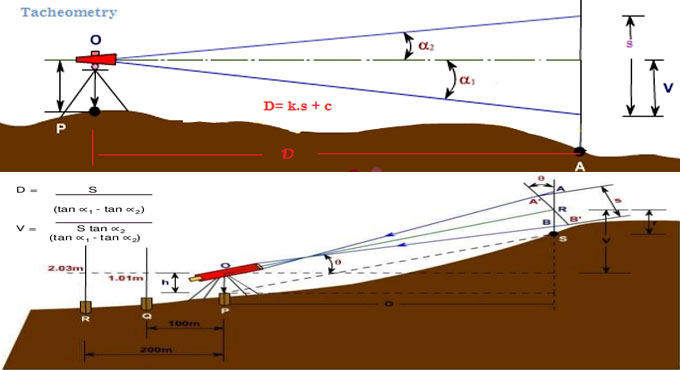
What is Tacheometric Surveying and What are it?s Methods
Tacheometry is a piece of investigating where level and vertical detachments are constrained by taking dashing recognitions with an instrument known as a tacheometer. The tying down undertaking is completely shed in such an investigation.
Tacheometric examining is grasped in an upsetting and inconvenient area where direct leveling and securing are either ridiculous or astoundingly dull. It is in like manner used in territory surveys for railways, roads, stores, etc.
In spite of the way that is not incredibly definite, tacheometric investigating is quick, and a reasonable structure guide can be set up for assessment works inside a concise range dependent on such examination.
What is a Tacheometer?
A tacheometer resembles a standard travel theodolite fitted with stadia wires despite the central view. As exactness and speed are principal, the telescope fitted with a tacheometer must fulfill additional necessities.
Moreover, the vertical hover should be progressively refined. The telescope of the tacheometer is commonly longer than that of the Ordinary theodolite and has a higher power of enhancement.
The article glass is of increasingly significant separation over, and the point of convergence structure is of better quality.
The intensification power should not be under 20-25. The suitable opening should not be under 3.5-4.5 cm in separation across empowering the getting of a splendid picture. The expanding predictable of the instrument (f/I) is regularly kept as 100. Every so often an additional pair of views is given to such a degree, that the expanding predictable (f/I) is 50.
This is used for close sights. As the top and base hairs are examined, game-plans may be given by rack-and-pinion to the improvement of the eyepiece in the vertical plane. It ought to be possible to take direct readings to a limited extent of 5 degrees on the vertical circle.
A sensitive spirit level should be fixed on the "underarm." An instrument fulfilling the above necessities is used in fixed hair strategy for stadia inspecting. For use in the portable hair procedure for stadia investigating, the above tacheometer will have a substitute kind of stomach.
Generally, the fixed central crosshair and the vertical hair are reached out in the stomach plot. The portable top and base spotlight are mounted on different slides which can be moved by a micrometer screw. The stomach and the slides passing on the stadia wires are arranged in different vertical planes to check mileage.
Micrometer screws which work the stadia hairs are given prepared heads and drum scales. The drums are divided into 100 segments. Readings may be taken up to 0.001 of the pitch of the screws. This instrument is also called a subtense theodolite.
Techniques for Tachometric Survey
Various systems for tacheometry study rely upon the standard that the level detachment between an instrument Station "An" and a staff station "B" dependent upon the edge subtended at point "A" by a known division at point "B" and the vertical edge from point "B" to point "An" independently.
This rule is used in different procedures in different ways. For the most part there are two methods for tacheometry outline.
1. Stadia framework
2. Distracting framework
Stadia System of Tacheometry: In the stadia structure, the level division to the staff Station from the instrument station and the tallness of the staff station concerning the distinguishable pathway of the instrument is obtained with only a solitary recognition from the instrument Station.
In the stadia procedure, there are for the most part two structures of assessing: fixed hair technique, versatile hair strategy and Fixed Hair Method.
In the fixed hair system for tacheometric contemplating, the instrument used for taking observations include a telescope fitted with two additional level views one above and the other underneath the central hair.
These are put equidistant from the central hair and are called stadia hairs.
Exactly when a staff is seen through the telescope, the stadia hairs are accepted to catch a particular length of the staff, and this shifts directly with the detachment between the instrument and the stations.
As the detachment between the stadia hair is fixed, this procedure is known as the "fixed hair method."
Mobile Hair Method: In the convenient Hair method for tacheometric investigating, the instrument used for taking recognitions involve a telescope fitted with stadia hairs which can be moved and fixed at any division from the central hair (inside the limits of the stomach).
The staff used with this instrument involves two targets (marks) at a fixed partition isolated (state 3.4 mm).
The Stadia between time which is variable for the different spots of the staff is assessed, and the level detachment from the instrument station to the staff station is handled.
Digressive System of Tacheometric Surveying: Right now tacheometric contemplating, two discernments will be crucial from the instrument station to the staff station to choose the even detachment and the differentiation in the tallness between the line of collimation and the staff station.
The primary good situation of this procedure is that this review can be driven with customary travel theodolite.
As the traditional travel theodolite is more affordable than the complex and continuously refined tacheometer, thus, the diagram will be progressively useful.
Right now, far from the decline of field notes, detachments and rises are concerned there isn't a lot of differentiation between these two systems.
Regardless, this structure is seen as shoddy contrasted with the stadia system as a result of the going with reasons and is just every once in a while used nowadays.
This incorporates estimation of two vertical edges, and the instrument may get bothers between the two recognitions.
The speed is diminished due to dynamically number of recognitions and the modifications noticeable all around conditions will impact the readings stunningly.
The staff used right now like the one used in the versatile hair method for stadia investigating. The partition between the targets or vanes may be 3-4 m.


